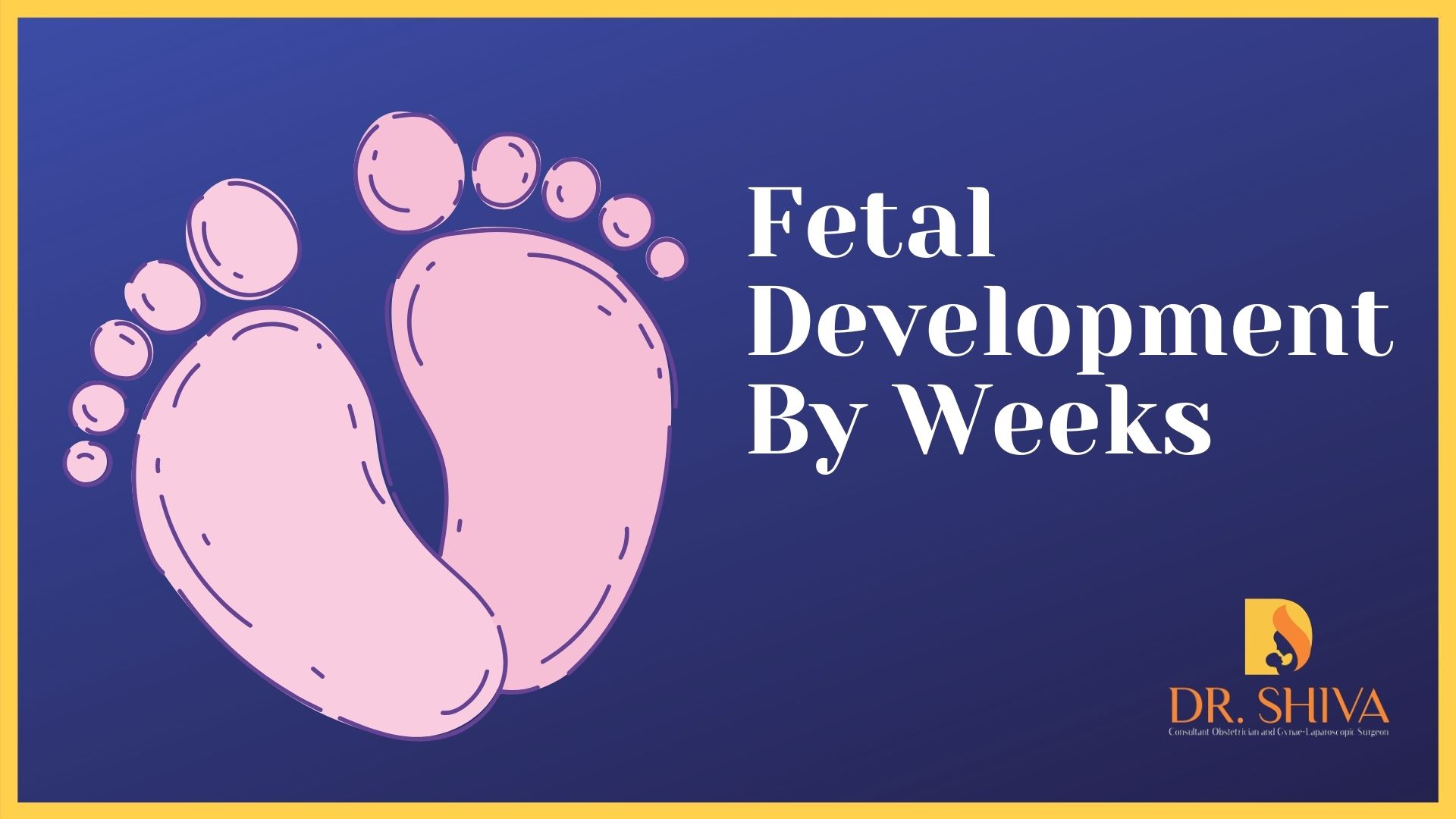
From the moment a woman realizes that she is pregnant she would be anxious to learn about the fetal development happening every week to her baby inside the uterus. Below are the advancements that happen week after week from the time the zygote (single cell formed from the DNA of mother and father) was created to a full term baby. The first eight weeks is embryonic period and rest 30 weeks is known as the fetal period.
Week 1 and 2
We start counting weeks from the first day of the last menstrual period you have had. It is during the end of the second week that you may have a chance to conceive in case you have had intercourse.
Week 3
The sperm and egg unite to form a zygote in the fallopian tube. The zygote contains the DNA information from mother and father. After fertilization, it will move towards the uterus.
Week 4
The zygote cells will divide to form a blastocyst which will bury itself in the uterine wall and implantation takes place. The inner cells form the embryo and outer cells placenta.
Week 5
Size of sesame seed
Heart and blood vessels begin to develop along with the nervous system. You will miss your next period and may show positive for a pregnancy test taken during this time. The fetus will be in tadpole shape with three layers of cell which later gives develops to different organs, skin and hair.
Week 6
Size of lentil (0.25 inch .635cm)
A shape for head starts to come and the facial features i.e. the eyes, mouth and ears begin to develop. The heart starts to beat and at a rate faster than ours, around 100 beats per minute. Limb buds start developing for arms and legs. Skin developed now is very thin, almost transparent. The neural tube will close starts to form the brain and spinal cord.
Week 7
Size of blueberry (1cm).
The arms and legs start to grow in length. The inner ear is almost developed. At this stage, the brain is growing faster than the body. The face is also developing. The heart beat may be seen via vaginal ultrasound.
Week 8
Size of a kidney bean (Half inch,1.1g).
The face starts to form along with eyelids, mouth and ears. The nose starts taking shape and part of the brain involved in sense of smell is developing. Fingers start growing. Kidney, heart, liver and gut start to develop. The tail part shrinks to form tailbone. Lungs start to develop.
Week 9
Size of grape (0.9 inch,1.9g)
The heart would have completed its division into 4 chambers. The ears, fingers and toes are clearly defined now. Small buds in the mouth now develop into milk teeth later. Ankle, elbows and knee joints start forming.
Week 10
Size of green olive (1.25 inch, 3.9g)
The placenta will be fully developed which will provide all the required nutrients to the fetus. The eyelids are fused. Limbs have developed. Kidney, intestine, brain, liver starts to function.
Week 11
Size of fig (1.61 inch, 7g)
Nails start to develop. They start to move a lot but you may start feeling it around 18 to 20 weeks only. Veins and arteries are developing at this stage.
Week 12
Size of lime (2 inches, 14g)
The fetus may start to make movements and sex organs begin to develop. Skeleton made of cartilage starts developing into bone. The baby can now close fingers to form a fist.
Week 13
Size of peach (2.9 inch, 23g).
Baby may start to suck its thumb. The intestines which have developed in the umbilical cord has moved into the abdomen. The fetus will start to swallow amniotic fluid and after the nutrients are absorbed the excess is passed in the form of urine into the amniotic fluid. If it’s a boy the testicles would have developed and for a girl the ovaries are developing.
Week 14
Size of lemon (3.9 inch, 14g).
Neck has developed and the arms are in proportion with the body. Hair called lanugo starts to appear on the head. The baby may start to make small expressions as a result of impulses from the brain.
Week 15
Size of apple (4 inch, 68g).
Breathing and digestive system are improving. Baby may be able to hear your voice and heartbeat.
Week 16
Size of avocado (4.3 to 4.6 inches,100g).
Fingerprints start to develop. Neck muscles are stronger. The circulatory system is fully functional now.
Week 17
Size of turnip (5.12 inch, 140g)
Fingerprints continue to develop. Eyes have now moved forward from the side of the head. The skeleton is hardening to form the bone.
Week 18
Size of ball pepper (5.6 inch, 190g).
Legs have grown longer and outer ears have fully developed. In the lungs smaller tubes start to branch from the main which enables blood flow. An anomaly scan is usually taken between 18 to 21 weeks. You may able to identify the gender of the baby in the scan taken in this period.
Week 19
Size of mango (6 inch, 238g)
Hair starts to sprout from the scalp. Different parts of the brain specialized in vision, smell, taste, hearing and touch starts to develop now. You may start to feel the baby movements (also known as quickening) from now on.
Week 20
Size of banana (10 inch, 283g)
You have completed half of the pregnancy term. The baby is more active. During the anomaly scan taken in this period, the measure of head, abdomen and thigh femur will be taken. A substance called vernix caseosa will start to form within the pores which will later help to protect the skin from long immersion in the amniotic fluid. You can start feeling your baby move. They can yawn and stretch. An ultrasound is usually taken now to make sure the baby is growing fine and is healthy. Will be able to identify the child’s gender.
Week 21
Size of carrot (10.58 inch, 340g)
The hair is becoming thicker especially on the head and eyebrow part. You may start to feel more actions from the baby and also identify that there is a pattern in its movement, i.e., between being active and taking rest.
Week 22
Size of squash (11 inch, 425g)
The eyes have formed but irises are not yet pigmented. Any waste product from the baby’s body is to be processed by the mother’s, hence the mother’s kidney will have more work.
Week 23
Size of grapefruit (11.4 inch, 498g).
In the coming weeks, baby’s movements may be visible on the surface of your tummy. For some, it may take longer. The different sounds are clearer to the baby.
Week 24
Size of corn (1 foot long, 589g)
Baby starts responding to sounds. The inner ear will be fully developed. By now her lungs are developed such that if born prematurely there is a chance of survival. The baby will have a pattern for sleep and being awake. The baby’s kicks will start getting stronger.
Week 25
Size of cauliflower (13.6 inch, 680g)
Baby starts getting chubbier. The wrinkles of the skin start to disappear as it starts to store fat. Baby may respond to loud noises by sudden jumping or kicking.
Week 26
Size of head of kale (14 inch, 771g)
Baby can hear more distinctively. This is time for bonding with the child as it may be able to identify your and your partner’s voice. Surfactant develops inside the lungs which help the air sacs to inflate and deflate. By now taste buds would have developed fully.
Week 27
Size of cauliflower (14.4 inch, 861g).
Baby may start to open its eyes and start to be aware of bright light from your tummy. They also breathe more actively through the amniotic fluid which will help develop their lungs.
Week 28
Size of large eggplant (15inch and over a kg weight).
Myelin starts developing around the spinal cord with nerves coming from it. The myelin helps send messages in speed between the nerves and the brain. Baby starts changing positions. If you go into labor now due to any reason there is a chance for the baby to survive.
Week 29
Size of butternut squash (15.2 inch, 1.1 kg).
Skeleton continues to harden and you should have good calcium intake to contribute to the calcium requirement for the baby’s bones. The brain is also growing in size.
Week 30
Size of large cabbage (15.7 inch,1.3kg).
The growth rate of babies usually starts to go down during this period but they will continue to have an increase in weight. Vernix, the white moisturizing substance coats all over the body to protect the skin. The baby may respond to torch light.
Week 31
Size of large coconut (16.2inch, 1.4 kg)
The wrinkles start to reduce in the skin as the baby continues to gain weight. The baby usually sleeps for 20 to 40 minutes but not more than 90 minutes. He slowly takes a fetal position because of lesser space.
Week 32
Size of Chinese cabbage (16.7 inch, 1.7kg)
Baby would have gained half its weight by now. A yellow fluid known as colostrum may start coming from your breast. The fingernails are fully formed. Toenails are also visible. If born in this week, chances of survival are good.
Week 33
Size of Pineapple (17.2 inch, 1.9kg).
The brain develops fast. The skull is soft and the plates of bones are not yet fused.
Week 34
Size of butternut squash, melon (17.7 inch, 2.1kg).
If born now will only need slight help from the neonatal unit. By now the baby will be able to identify the mother’s and partner’s voice. Can sing lullabies to baby which she may recognize once she comes out too.
Week 35
Size of honeydew melon (18 inch, 2.4kg)
You may be able to see the baby’s movements just by looking at your bump. The amount of amniotic fluid may start to reduce to give more space to the baby.
Week 36
Size of Swiss chard (18.6 inch, 2.6kg).
The brain is developing fast and the lungs are almost fully developed. By now in most cases, the head is positioned down. Due to this the bump will have moved down known as lightening. If your baby is in a breech position or lying across the doctor may suggest to turn the baby around. For this, the doctor will apply gentle pressure to help the baby turn. The nervous system is also developing fast. She continues to shed the vernix and hair which she may swallow and after digestions will form the meconium which is her first poo after birth.
Week 37
Size of rhubarb (19 inch, 2.8kg)
Baby is ready for birth and may happen anytime. For some, it may extend to even 42 weeks. The digestive system is developing and the small intestine also keeps growing. The baby may make different facial expressions as they are working out its muscles. You may experience Braxton Hicks Contractions
Week 38
Size of pumpkin (19.5 inch, 3kg)
A large part of hair must have gone by now. They can grasp their hands.
Week 39
Size of watermelon (20 inch, 3.1kg).
Baby’s organs are well developed. Old skin is replaced with a new one. You may have thick discharge like the mucous before delivery. Once outside the baby will cry immediately to get their airways cleared and help get into a breathing pattern.
Week 40
Size of jackfruit (20.2 inch, 3.4kg).
By now you have reached your due date but in some cases, the delivery may extend up to 42 weeks. There are two soft spots on the baby’s head that have not fused which enable the skull bones to overlap during the vaginal birth. It will get back into shape a few days after the birth. The baby will also instinctively search for the nipple to feed on after birth.
For more details on fetal developments or any other related concerns contact us.


Recent Comments